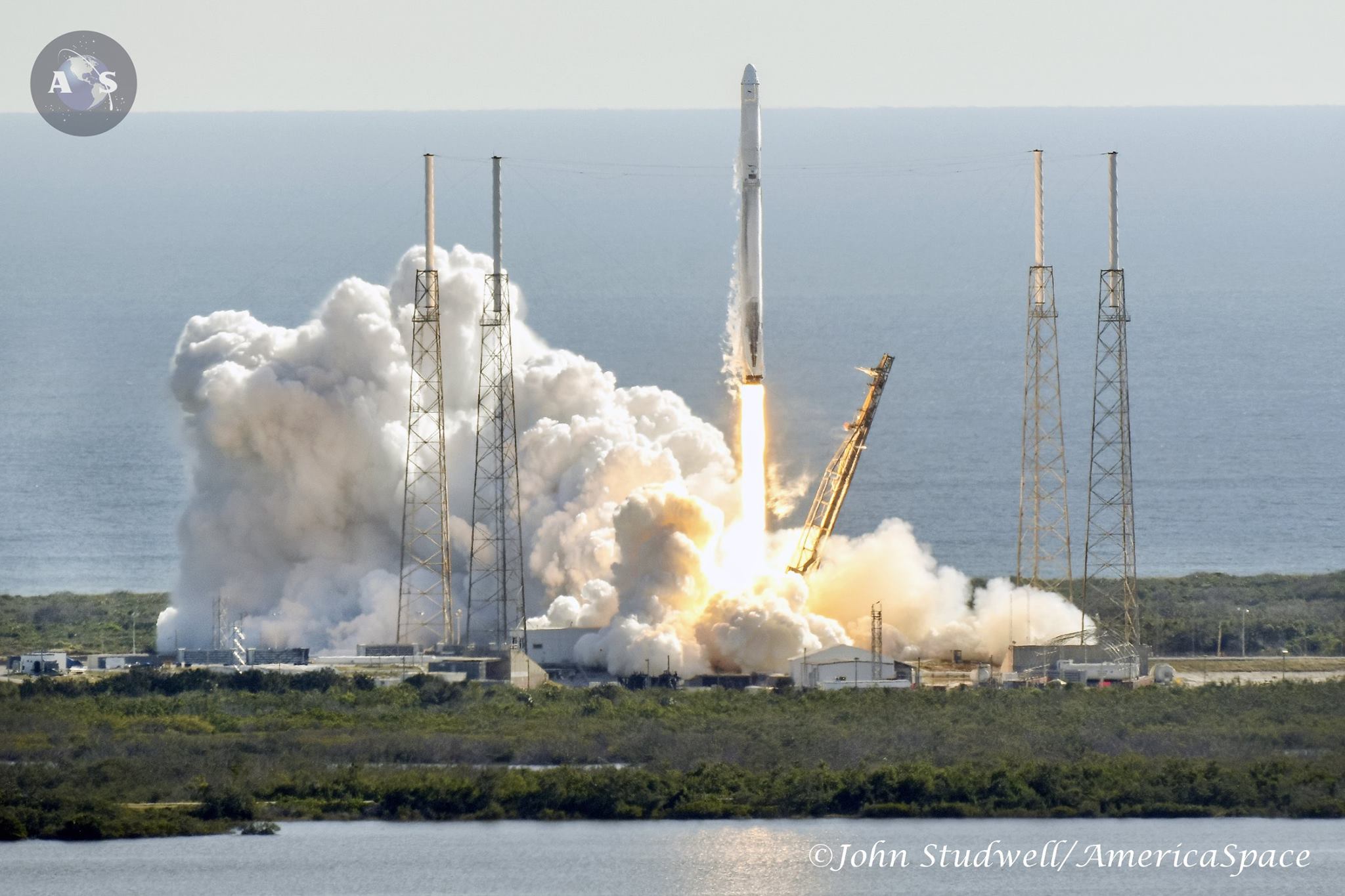
Space Launch Complex (SLC)-40 at Cape Canaveral Air Force Station, Fla., which endured significant damage in the wake of last year’s Amos-6 explosion, has been triumphantly returned to flight operations, ticking off more than 80 launches in over five decades of service. SpaceX’s venerable Upgraded Falcon 9 roared aloft from the old pad at 10:36 a.m. EST Friday, 15 December, smoothly delivering the CRS-13 Dragon cargo ship onto a two-day rendezvous profile to reach the International Space Station (ISS).
Current plans are for Dragon—which is being flown under the provisions of the Commercial Resupply Services contracts, initially signed between SpaceX and NASA in December 2008—to arrive at the station early Sunday, 17 December. It will be robotically berthed at the Harmony node, where it will remain for the next four weeks.
Today’s flight carried a novel “first”, in that both the Upgraded Falcon 9 first stage and the Dragon cargo ship have flown before. Interestingly, although the landing legs of the first stage have been cleaned, the rest of the lower half of the booster still sported lines of soot from its previous return through the atmosphere. A successful landing of the first stage on Landing Zone (LZ)-1 at the Cape brings to 20 the total number of fully successful landings of Upgraded Falcon 9 boosters, since December 2015. This includes 12 landings at sea, on the Autonomous Spaceport Drone Ship (ASDS), and eight on solid ground in Florida.
SLC-40 was originally developed in the heyday of the “Space Race”, back in the early 1960s, as part of the Integrate-Transfer-Launch (ITL) facility for the Air Force’s Titan rocket family. It first supported a test flight of the Titan IIIC on 18 June 1965, which delivered a lead-ballast “trans-stage” into orbit. This was the first of 55 Titan vehicles to fly from SLC-40 over the next four decades, delivering a myriad of classified payloads, including Defense Support Program (DSP) early-warning satellites, Defense Satellite Communications System (DSCS) and Milstar communications satellites and a flotilla of signals reconnaissance satellites, including the “Advanced Orion”.
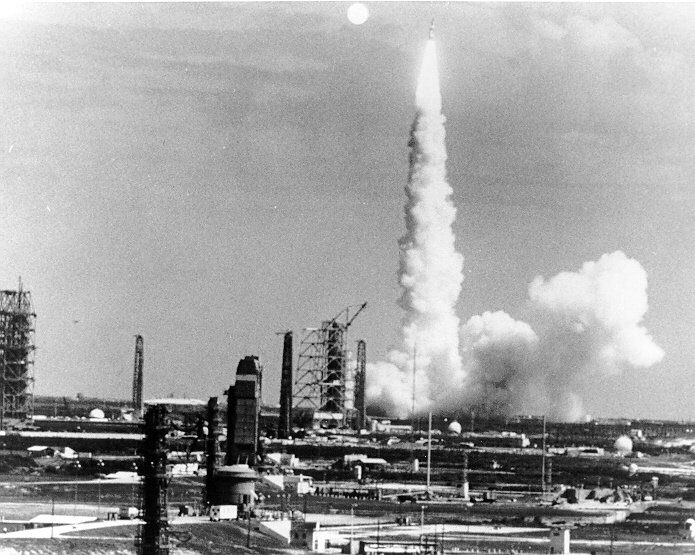
18 June 1965. Photo: USAF
Dovetailed into SLC-40’s military mix were a number of civilian and scientific missions. NASA’s Applications Technology Satellite (ATS)-6 flew in May 1974 and the pad also provided the foundation to launch the four missions of the Commercial Titan III in the early 1990s, whose payloads notably included Intelsat 603—subsequently retrieved and reboosted by the Space Shuttle—and the ill-fated Mars Observer. Then, in October 1997, SLC-40 saw the departure of the Cassini mission to Saturn. The pad saw its final Titan launch in April 2005, after which it was mothballed. Two years later, the Air Force Space Command granted permission for SpaceX to take over the site for its Falcon launch vehicle operations.
Since June 2010 and including today’s flight of CRS-13, the Hawthorne, Calif.-headquartered SpaceX has staged 27 successful launches of its Falcon fleet, delivering 13 Dragons successfully to the space station and a multitude of other payloads into orbit. However, on 1 September 2016, during preparations to launch the Amos-6 communications satellite to Geostationary Transfer Orbit (GTO), the Upgraded Falcon 9 exploded on the pad, completely destroying the vehicle and causing significant damage to SLC-40 itself.
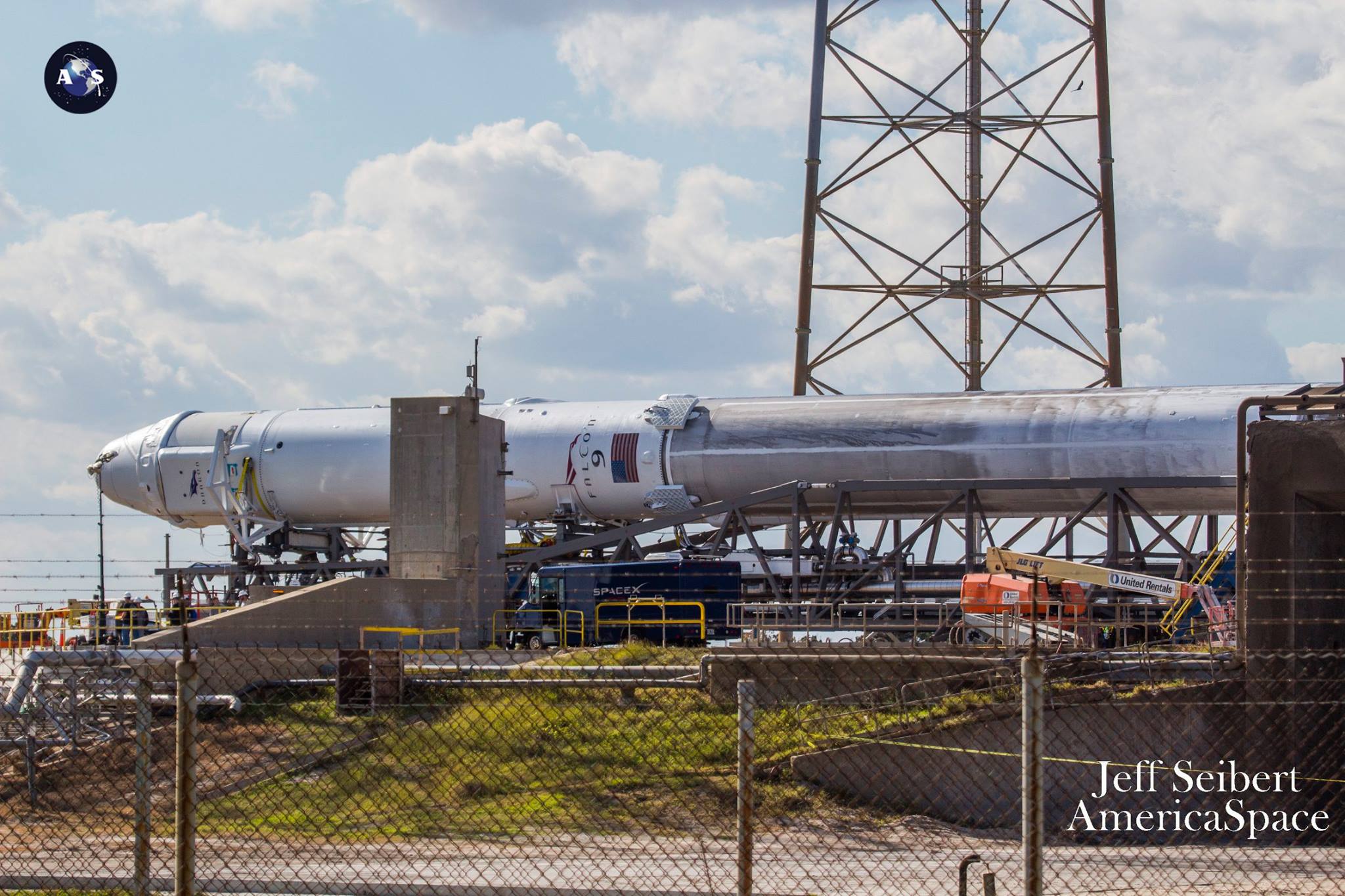
Since then, a raft of enhancements have been made, including the installation of flame diverters, an improved strongback, an upgraded liquid oxygen loading apparatus and, more generally, a more reliable suite of redundant systems. Fifteen months after the Amos-6 loss, SpaceX conducted a customary Static Fire Test of the nine Merlin 1D+ first-stage engines aboard the Upgraded Falcon 9 on Wednesday, 6 December. “Static fire test of the Falcon complete,” SpaceX tweeted. “Targeting launch of CRS-13 on December 12.” It was also noted that the classified Zuma mission for an undisclosed U.S. Government agency has been rescheduled for early January, having been delayed since mid-November. The Zuma mission will also launch from SLC-40.
Unsurprisingly, in view of the fact that SLC-40 has undergone a lengthy period of modification and refurbishment since the Amos-6 incident, additional delays were incurred. Late Monday, SpaceX tweeted a revised launch date of Wednesday, 13 December, “to allow for additional time for pre-launch ground systems checks”. This was further modified to Friday, 15 December, with the footnote that a delay beyond this date would result in an unavoidable slip until the end of the month. “Taking additional time for the team to conduct full inspections and cleanings, due to detection of particles in 2nd stage fuel system,” the company noted. “Now targeting CRS-13 launch from SLC-40 on Dec. 15. Next opportunity would be no earlier than late December.”
Early Friday, the 230-foot-tall (70-meter) Upgraded Falcon 9 was elevated to the vertical at the pad, with weather forecasters predicting a 90-percent likelihood of acceptable conditions at T-0. “Winds will shift to the southwest today and cloud cover will begin to push into the area at the low levels,” the 45th Space Wing at Patrick Air Force Base noted in its L-1 weather briefing on Thursday morning. “A strong sub-tropical ridge is currently entrenched over Central Florida and is preventing a weak surface front located through the Central U.S. from pushing into our area. This ridge will weaken late on Friday and into Saturday, allowing the front to push south well after the launch window.” It was cautioned that cloud cover would likely be present for Friday’s launch attempt, as southwesterly-moving winds push moisture into the area, presenting a potential violation of the Thick Cloud Rule.
As was customary for ISS-bound launches, Friday’s T-0 was “instantaneous”, with no wiggle-room for pauses in the countdown, due to hardware or weather issues. Loading of the Upgraded Falcon 9 with liquid oxygen and a highly refined form of rocket-grade kerosene (known as “RP-1”) got underway about an hour before launch. Since last September’s on-the-pad explosion of Amos-6, the booster has been put through a slightly longer fueling regime.
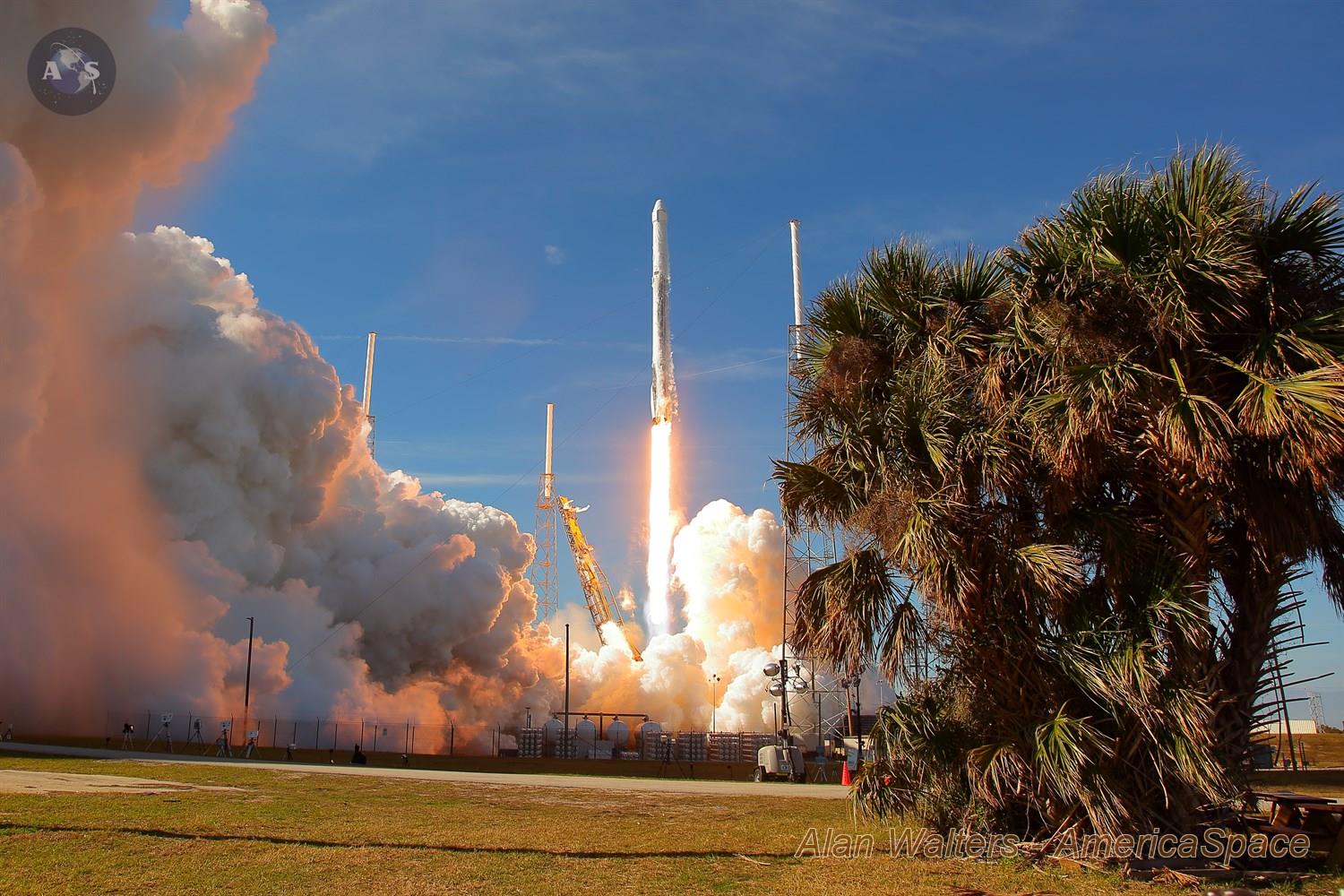
Passing T-10 minutes, the terminal countdown autosequencer was initiated and the nine Merlin 1D+ engines of the first stage, configured in a circle of eight, with a ninth at the center, were chilled-down, ahead of the ignition sequence. At T-2 minutes, the Air Force Range Safety Officer declared all ground assets as “Go for Launch” and the Upgraded Falcon 9 transitioned to Internal Power and assumed primary command of all critical functions, going into “Startup” at T-1 minute. At this stage, the Niagara deluge system began flooding the pad surface with 30,000 gallons (113,500 liters) of water, per minute, to suppress the acoustic energy. The Eastern Range declared its readiness as “Green”.
Three seconds before liftoff, the Merlins roared to life, pumping out a combined thrust of 1.5 million pounds (680,000 kg) of thrust. Liftoff occurred on-time at 10:36 a.m. EST. Immediately after clearing the tower, the Upgraded Falcon 9 executed a combined pitch, roll and yaw program maneuver to establish itself onto the proper flight azimuth to inject the CRS-12 Dragon into orbit at an inclination of 51.6 degrees to the equator. Passing the point of maximum aerodynamic turbulence (colloquially dubbed “Max Q”) at 70 seconds into the flight, the booster later throttled back two of the Merlins to reduce the rate of acceleration at Main Engine Cutoff (MECO). Two and a half minutes after launch, the seven remaining Merlins fell silent and the first stage separated from the stack.
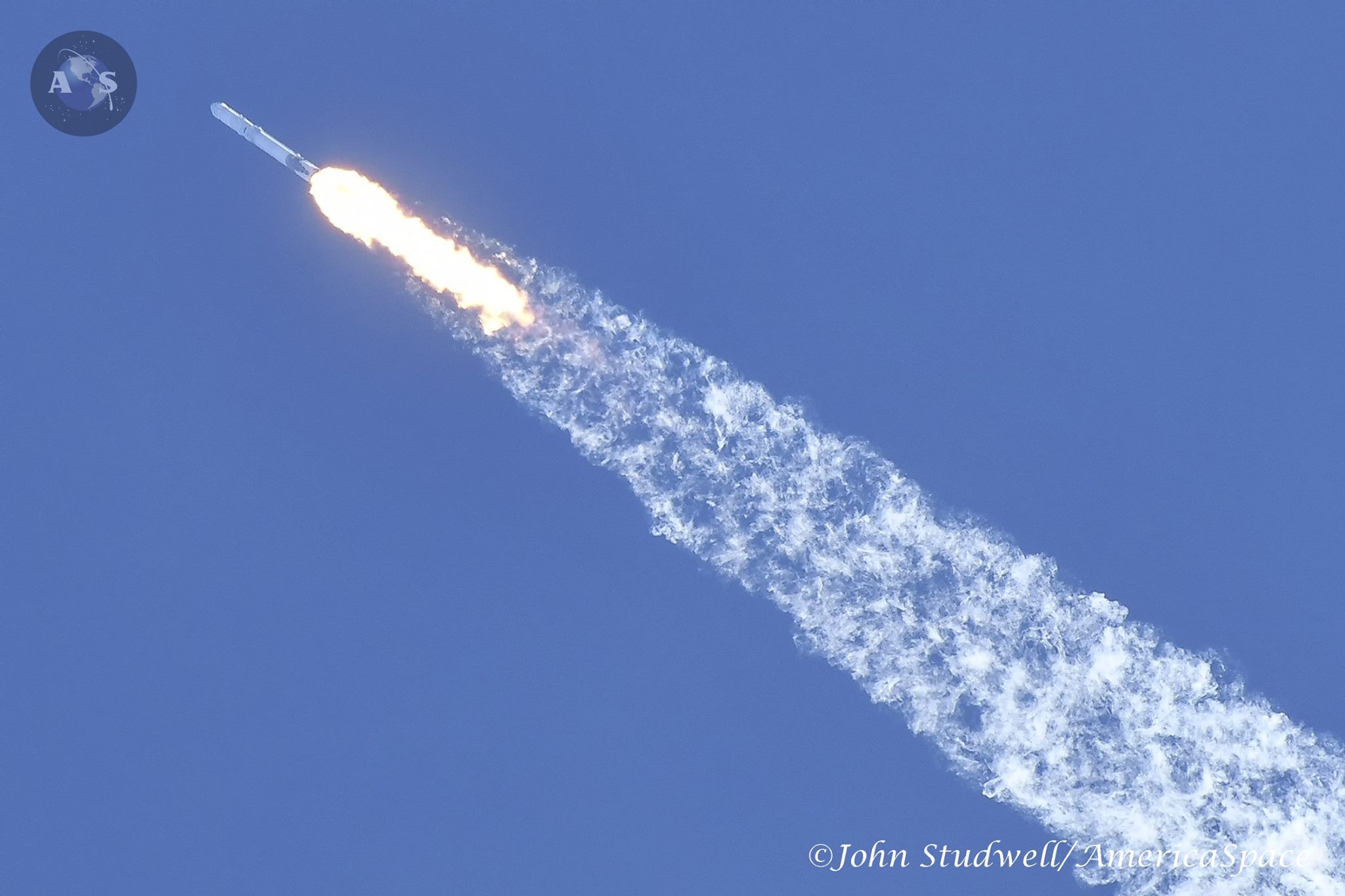
It was now the turn of the second stage, equipped with a single, restartable Merlin 1D+ Vacuum engine, capable of 210,000 pounds (92,250 kg). This now picked up the baton to deliver its payload into low-Earth orbit. During its burn, the protective nose fairing—covering Dragon’s berthing mechanism—was jettisoned and the spacecraft separated from the second stage a little under ten minutes after launch. Shortly thereafter, its pair of power-generating solar arrays were deployed. By 2.5 hours into the flight, Dragon’s Guidance and Navigation Control (GNC) Bay Door was opened to expose critical rendezvous sensors, ahead of the two-day journey to the ISS.
As with its predecessors, CRS-13 will approach the space station along the “R-Bar” (or “Earth Radius Vector”), which provides an imaginary line from Earth’s center, effectively approaching from “below”. In so doing, Dragon will take advantage of natural gravitational forces to brake its final approach and reduce the need to perform excessive numbers of thruster firings. By Sunday morning, it will reach a “Hold Point” about 1.5 miles (2.4 km) from the station, whereupon it must pass a “Go/No-Go” poll of flight controllers in order to draw nearer.
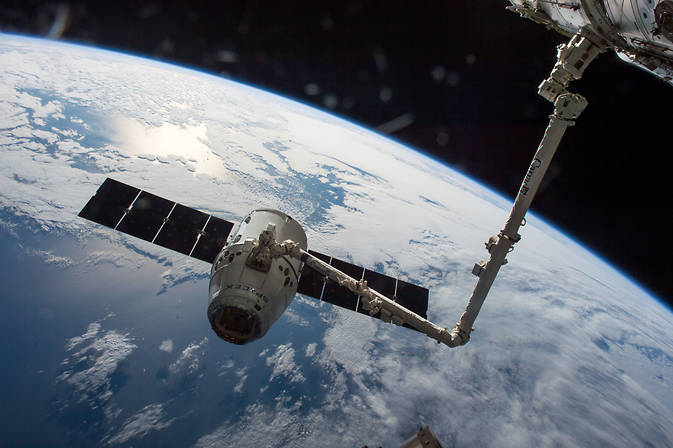
Further polls and holds will be made at distances of 3,700 feet (1,130 meters) and 820 feet (250 meters), after which Dragon will creep toward its target at less than 3 inches (7.6 cm) per second. Critically, at 650 feet (200 meters), it will enter the “Keep-Out Sphere” (KOS), which provides a collision avoidance exclusion zone, and its rate of closure will be slowed yet further to just under 2 inches (5 cm) per second.
After clearance has been granted for the robotic visitor to advance to the 30-foot (10-meter) “Capture Point”, the final stage of the rendezvous will get underway, bringing Dragon within range of the station’s 57.7-foot-long (17.6-meter) Canadarm2 and capture by Expedition 53 Flight Engineers Mark Vande Hei and Joe Acaba. Both crew members will be based in the multi-windowed cupola for the operation. It is expected that CRS-13 will remain attached to the space station until mid-January.
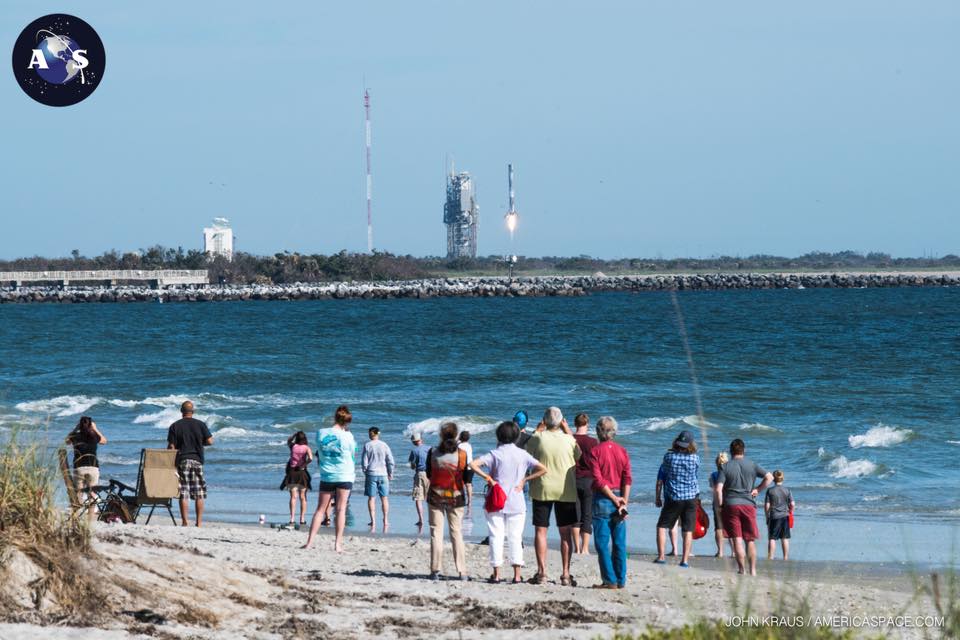
Although the primary focus of today’s launch was to deliver the CRS-13 Dragon into orbit, the discarded first stage was assigned the secondary objective of returning to a soft landing on the Landing Zone (LZ)-1 pad at Cape Canaveral Air Force Station. SpaceX’s record of bringing its Falcon hardware back through the “sensible” atmosphere has evolved considerably over the last three years. To date, 12 Falcon 9 first stages have successfully landed on the Autonomous Spaceport Drone Ship (ASDS) in either the Atlantic or Pacific Oceans and—including today’s mission—eight have alighted on solid ground at LZ-1. Thus, SpaceX has brought first stages in an intact state back to Earth on 20 occasions in the 24 months since December 2015.
Less than three minutes after leaving SLC-40, the Upgraded Falcon 9’s first stage executed the first “burn” of its Merlin 1D+ engines—the so-called “Boost-Back”—which adjusted the impact point, pushing it upward and directly it towards LZ-1. Assisted by on-board nitrogen-fed thrusters, the first stage “flipped” over and performed Entry and Landing burns to incrementally slow it down, initially to about 560 mph (900 km/h) and eventually a touchdown velocity of 4.5 mph (7.2 km/h). Controlling the first stage’s lift vector were four lattice-like hypersonic grid fins, configured in an “X-wing” layout, and the Falcon touched down perfectly on LZ-1, some seven minutes and 46 seconds after departing the Cape.
FOLLOW AmericaSpace on Facebook!
.
Missions » ISS » COTS » CRS-13 »



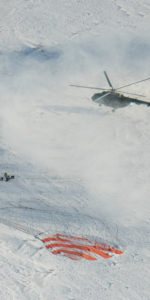
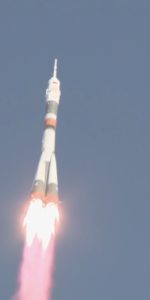
if 17 > ULA_LAUNCH_RECORD:
print ‘steamroller continues’
The standings for 2017 as of Dec 15
28 United States (including SpaceX)
19 Russia
17 SpaceX
15 China
11 ESA (including Soyuz LV)
0 Gary Church